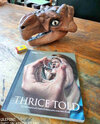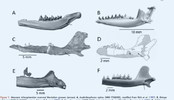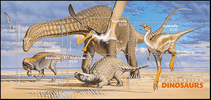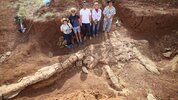- Oct 1, 2014
- 6,237
- 13,402
- AFL Club
- Hawthorn
- Thread starter
- #76
The placoderm and Devonian fish thing continues.

From the Gogo Formation in the Kimberley region of Western Australia we have one of the most amazing late Devonian fossils in the world, a single specimen of Materpiscis attenboroughi , the genus name means mother fish and the species name comes from Sir David. Just under a foot long, it has a sort of cartoon appearance. What is unique is there is an unborn embryo present inside the mother, including preservation of a mineralised umbilical cord and placenta.

While it was a bad day for mother & daughter, it's an incredible find for us. At 380 million years old, it is the oldest known vertebrate to give birth to live young. This magazine article talks more about it - Your Weekly Attenborough: Materpiscis attenboroughi | Discover Magazine
There were some big beasties during the Devonian, this graphic depicts some very large and nasty looking Placoderms and sea scorpions.


From the Gogo Formation in the Kimberley region of Western Australia we have one of the most amazing late Devonian fossils in the world, a single specimen of Materpiscis attenboroughi , the genus name means mother fish and the species name comes from Sir David. Just under a foot long, it has a sort of cartoon appearance. What is unique is there is an unborn embryo present inside the mother, including preservation of a mineralised umbilical cord and placenta.

While it was a bad day for mother & daughter, it's an incredible find for us. At 380 million years old, it is the oldest known vertebrate to give birth to live young. This magazine article talks more about it - Your Weekly Attenborough: Materpiscis attenboroughi | Discover Magazine
There were some big beasties during the Devonian, this graphic depicts some very large and nasty looking Placoderms and sea scorpions.

Last edited:



















